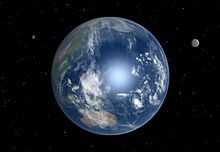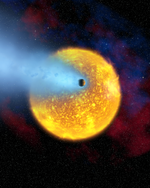



Various unknown astronomical objects have been hypothesized throughout recorded history. For example, in the 5th century BCE, the philosopher Philolaus defined a hypothetical astronomical object which he called the "Central Fire", around which he proposed other celestial bodies (including the Sun) moved.
Types of hypothetical astronomical objects
Hypothetical astronomical objects have been speculated to exist both inside and outside of the Solar System, and speculation has included different kinds of stars, planets, and other astronomical objects.
- For hypothetical astronomical objects in the Solar System, see: List of hypothetical Solar System objects
- For hypothetical stars, see: Hypothetical star
- For hypothetical brown dwarfs, see: List of brown dwarfs
- For hypothetical black holes, see: Hypothetical black hole
- For extrasolar moons, all of which are currently hypothetical, see: Extrasolar moon
- For stars, planets or moons whose existence is not accepted by science, see: Planetary objects proposed in religion, astrology, ufology and pseudoscience and Stars proposed in religion
- For hypothetical planets in fiction, see: Fictional planets of the Solar System
Hypothetical planet types
Hypothetical types of extrasolar planets include:
| Type | Description |
|---|---|
| Ammonia planet | A planet with significant amounts of ammonia. May have lakes or oceans of ammonia. |
| Blanet | A planet that directly orbits a black hole. |
| Carbon planet | A terrestrial planet composed primarily of carbon, rather than silicon. |
| Chthonian planet | A hot Jupiter whose outer layers have been completely stripped off by its parent star. |
| Chlorine planet | A planet with significant amounts of free chlorine or hydrochloric acid and muriatic acid. |
| Coreless planet | A terrestrial planet that has no metallic core. |
| Desert planet | A terrestrial planet with little to no water. |
| Extragalactic planet | A planet that is located outside the Milky Way galaxy |
| Eyeball planet | A tidally locked planet where uneven heating of the surface induces spatial features resembling a human eye. |
| Helium planet | A gas giant composed mainly of helium instead of hydrogen. |
| Hycean planet /ˈhaɪʃən/ | A hot, water-covered planet with a hydrogen-rich atmosphere that is possibly capable of harboring extremophilic life. |
| Ocean planet | A planet whose surface is covered entirely by deep oceans. |
| Superhabitable planet | A terrestrial planet that is more habitable than Earth. |
| Tidally detached exomoon | A planet that was originally a moon but has become gravitationally detached. |
| Toroidal planet | A planet whose shape resembles a torus or doughnut. |
| Trojan planet | A planet that orbits near the L4 or L5 Lagrange points of a more massive object. |
References
- Marco Ceccarelli, Distinguished Figures in Mechanism and Machine Science (2007), p. 124.
- Haas, Johnson R. (November 2010). "The potential feasibility of chlorinic photosynthesis on exoplanets". Astrobiology. 10 (9): 953–963. Bibcode:2010AsBio..10..953H. doi:10.1089/ast.2009.0364. ISSN 1557-8070. PMID 21118026.
- Madhusudhan, Nikku; Piette, Anjali a. A.; Constantinou, Savvas (26 August 2021). "Habitability and Biosignatures of Hycean Worlds". The Astrophysical Journal. 918 (1): 1. arXiv:2108.10888. Bibcode:2021ApJ...918....1M. doi:10.3847/1538-4357/abfd9c. S2CID 237290118.
- Anderson, Paul Scott (29 August 2021). "Hycean planets might be habitable ocean worlds". Earth & Sky. Retrieved 12 December 2021.
- Davis, Nicola (25 August 2021). "'Mini-Neptunes' beyond solar system may soon yield signs of life – Cambridge astronomers identify new hycean class of habitable exoplanets, which could accelerate search for life". The Guardian. Retrieved 12 December 2021.